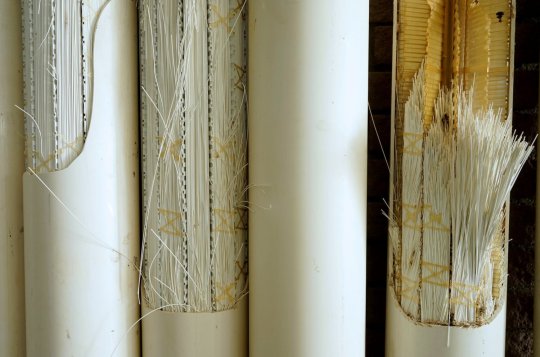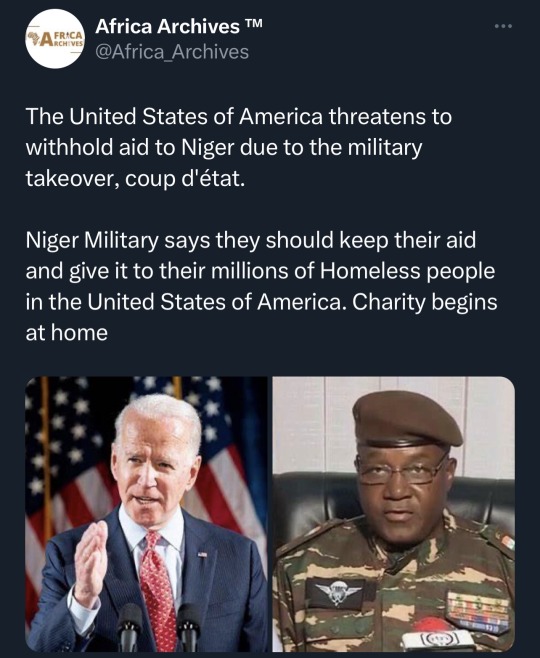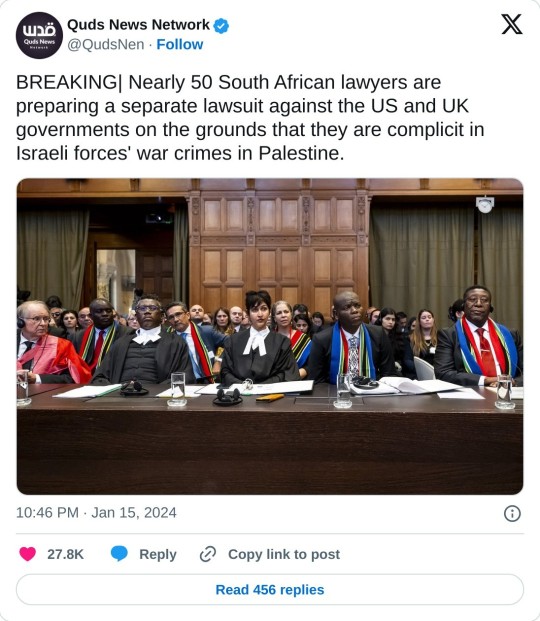#United States of Africa
Text
youtube
#black power#black excellence#malcolm x#united states of africa#Pan-Africanism#pan africanism#Marcus Garvey#Kwame Nkrumah#Julius Malema#Dr. Umar Johnson#dr umar#dr umar ifatunde#africa#mali#burkina faso#niger#guinea#Mamady Doumbouya#Assimi Goïta#Ibrahim Traoré#Abdourahamane Tiani#African Leaders#rbg#African Voices#African unity#African Revolutionaries#nigeria#ecowas#Abdel-Fatau Musah#pan african
19 notes
·
View notes
Text

#international#law#international law#israel#free palestine#palestine#gaza#israel massacre#israel is a terrorist state#free gaza#occupied palestine#us#united states#us government#fuck israel#south africa#yemen#news on gaza#mems#facts#important#humans rights
9K notes
·
View notes
Text

from SocialistVoice on X.com
This is MAJOR.
5K notes
·
View notes
Text

Look what's trending on Twitter!
0 notes
Text

#feminist#feminism#social justice#free palestine#palestine#freepalastine🇵🇸#free gaza#settler violence#settler colonialism#current events#us imperialism#western imperialism#south african politics#south africa#end the genocide#end the occupation#ceasefire now#united states#us politics#african politics#fuck biden#biden administration
4K notes
·
View notes
Text
"Namibia is the driest country in Sub-Saharan Africa, and home to two of the world’s most ancient deserts, the Kalahari and the Namib. The capital, Windhoek, is sandwiched between them, 400 miles away from the nearest perennial river and more than 300 miles away from the coast. Water is in short supply.
It’s hard to imagine life thriving in Windhoek, yet 477,000 people call it home, and 99 per cent of them have access to drinking water thanks to technology pioneered 55 years ago on the outskirts of the city. Now, some of the world’s biggest cities are embracing this technology as they adapt to the harshest impacts of climate change. But Namibia leads the way.
How did this come about? In the 1950s, Windhoek’s natural resources struggled to cope with a rapidly growing population, and severe water shortages gripped the city. But disaster forced innovation, and in 1968 the Goreangab Water Reclamation Plant in Windhoek became the first place in the world to produce drinking water directly from sewage, a process known as direct potable reuse (DPR).
That may sound revolting, but it’s completely safe. Dr Lucas van Vuuren, who was among those who pioneered Windhoek’s reclamation system, once said that “water should not be judged by its history, but by its quality”. And DPR ensures quality.
This is done using a continuous multi-barrier treatment devised in Windhoek during eight years of pilot studies in the 1960s. This process – which has been upgraded four times since 1968 – eliminates pollutants and safeguards against pathogens by harnessing bacteria to digest the human waste and remove it from the water. This partly mimics what happens when water is recycled in nature, but Windhoek does it all in under 24 hours...

Pictured: These ultrafiltration membranes help to remove bacteria, viruses and pathogens. Image: Margaret Courtney-Clarke
“We know that we have antibiotics in the water, preservatives from cosmetics, anti-corrosion prevention chemicals from the dishwasher,” Honer explains. “We find them and we remove them.”
Honer adds that online instruments monitor the water continuously, and staff ensure that only drinking water that meets World Health Organisation (WHO) guidelines is sent to homes. If any inconsistencies are detected, the plant goes into recycle mode and distribution is halted until correct values are restored.
“The most important rule is, and was, and always will be ‘safety first’,” says Honer. The facility has never been linked to an outbreak of waterborne disease, and now produces up to 5.5m gallons of drinking water every day – up to 35 per cent of the city’s consumption.
Namibians couldn’t survive without it, and as water shortages grip the planet, Windhoek’s insights and experience are more important than ever.
Interest from superpowers across the globe
In recent years, delegations from the US, France, Germany, India, Australia, Singapore, and the United Arab Emirates have visited Windhoek seeking solutions to water shortages in their own countries.
Megadrought conditions have gripped the US since 2001, and the Colorado River – which provides 40 million people with drinking water – has been running at just 50 per cent of its traditional flow. As a result, several states including Texas, California, Arizona and Colorado are beginning to embrace DPR.
Troy Walker is a water reuse practice leader at Hazen and Sawyer, an environmental engineering firm helping Arizona to develop its DPR regulations. He visited Windhoek last year. “It was about being able to see the success of their system, and then looking at some of the technical details and how that might look in a US facility or an Australian facility,” he said. “[Windhoek] has helped drive a lot of discussion in industry. [Innovation] doesn’t all have to come out of California or Texas.”

Pictured: The internal pipes and workings of Namibia's DPR plant. As water becomes scarcer in some parts, countries are looking to DPR for solutions. Image: Margaret Courtney-Clarke
Namibia has also helped overcome the biggest obstacle to DPR – public acceptance. Disgust is a powerful emotion, and sensationalist ‘toilet to tap’ headlines have dismantled support for water reuse projects in the past. Unfortunately, DPR’s biggest strength is also its biggest weakness, as the speed at which water can re-enter the system makes it especially vulnerable to prejudice, causing regulators to hesitate. “Technology has never been the reason why these projects don’t get built – it’s always public or political opposition,” says Patsy Tennyson, vice president of Katz and Associates, an American firm that specialises in public outreach and communications.
That’s why just a handful of facilities worldwide are currently doing DPR, with Windhoek standing alongside smaller schemes in the Philippines, South Africa and a hybrid facility in Big Spring, Texas. But that’s all changing. Drought and increased water scarcity worldwide are forcing us to change the way we think about water.
Now, the US is ready to take the plunge, and in 2025, El Paso Water will begin operating the first ‘direct to distribution’ DPR facility in North America, turning up to 10m gallons of wasterwater per day into purified drinking water – twice as much as Windhoek. San Diego, Los Angeles, California, as well as Phoenix, Arizona are also exploring the technology."
Of course, DPR is not a silver bullet in the fight against climate change. It cannot create water out of thin air, and it will not facilitate endless growth. But it does help cities become more climate resilient by reducing their reliance on natural sources, such as the Colorado River.
As other nations follow in Namibia’s footsteps, Windhoek may no longer take the lead after almost six decades in front.
“But Windhoek was the first,” Honer reminds me. “No one can take that away.”"
-via Positive.News, August 30, 2023
#namibia#africa#desert#water shortage#water conservation#dpr#potable water#water recycling#clean water#drought#united states#colorado river#science and technology#sanitation#good news#hope
2K notes
·
View notes
Text

#yemen#jerusalem#tel aviv#current events#palestine#free palestine#gaza#free gaza#news on gaza#palestine news#news update#war news#war on gaza#apartheid#imperialism#settler colonialism#palestinian state#security council#united nations#south africa
502 notes
·
View notes
Text

#uploads#protest#Niger#Africa#Biden#biden administration#biden harris#Nigeria#United States#us war crimes#us news#france#government#politics
1K notes
·
View notes
Text
BLACK AFRICA MUST SEVERE ALL TIES WITH THE WEST: WESTERN POWERS AS HISTORIC ENEMIES OF THE BLACK CONTINENT!

View On WordPress
0 notes
Text
Damn, the hate is real.

#palestine#free palestine#gaza#free gaza#free west bank#gaza strip#genocide#israel#social justice#human rights#middle east#south africa#united nations#idf#end israeli occupation#israel is a terrorist state#yemen#hamas#houthis#hezbollah
208 notes
·
View notes
Text

Exploring the United States of Africa: Resilience, Unity, and Pan-African Progress
#africa#united states of africa#mali#chad#nigeria#burkina faso#Pan-Africanism#pan africanism#Marcus Garvey#Kwame Nkrumah#Julius Malema#Dr. Umar Johnson#dr umar#dr umar ifatunde#niger#guinea#Mamady Doumbouya#Assimi Goïta#Ibrahim Traoré#Abdourahamane Tiani#African Leaders#rbg#African Voices#African unity#African Revolutionaries#ecowas#Abdel-Fatau Musah#pan african#thomas sankara#malcolm x
19 notes
·
View notes
Text
TUN UP
Max wayne ft highlight 🔥
#drake#taylorswift#maxwayne#spotify#hiphop#cardib#dancehall#music video#trap#dance#New York#new year 2024#japan#uk#America#United States#Africa#caribbean girls#China#college#billboard hot 100
191 notes
·
View notes
Text

President Franklin D. Roosevelt Seated in Jeep with Hat over his Heart, Reviewing Troops with General George Patton, Casablanca.
Date: January 18, 1943
NARA: 6728535
#Jeep#Willys MB#Slat Grille#Willys#MB#Military Jeep#United States Army#U.S. Army#US Army#Army#World War II#World War 2#WWII#WW2#WWII History#History#January#1943#Casablanca#Africa#President Franklin D. Roosevelt#Franklin D. Roosevelt#President#my post
98 notes
·
View notes
Text
Gentle Reminder: Neoliberalism needs fascism to thrive in order to sustain and serve its own settler-colonial impulses ✨️
#our world#free congo#free haiti#free palestine#free uganda#free south africa#free namibia#free yemen#free sudan#free hawaii#stop cop city#ecosystem of white supremacy#down with neoliberalism#down with imperialism#Israel is an apartheid state#United States of Apartheid#black lives matter#politics#let gaza free you#Malcolm X
89 notes
·
View notes
Text

United against Apartheid Israel.
JHB, South Africa. 28 October 2023.
#freepalestine#free palestine#free gaza#free free palestine#south africa stands with palestine#south africa#faces of palestine solidarity#palestian solidarity day of action#palestine solidarity#palestinian genocide#justice for palestine#palestine flag#pray for palestine#israel is a terrorist state#united against apartheid israel#israel is an apartheid state
106 notes
·
View notes
Text

#feminist#feminism#social justice#free palestine#palestine#freepalastine🇵🇸#free gaza#settler violence#settler colonialism#current events#south africa#south african politics#united kingdom#united states#world news#world politics#war crimes#us imperialism#western imperialism#end the occupation#ceasefire now
990 notes
·
View notes